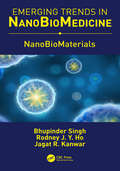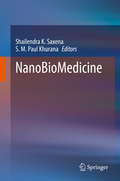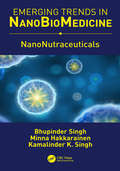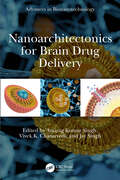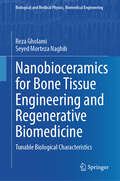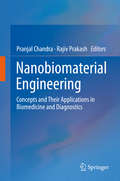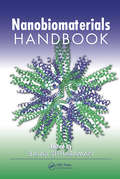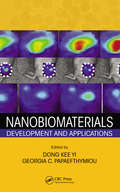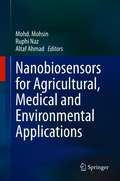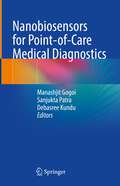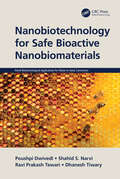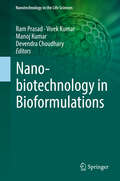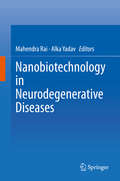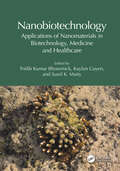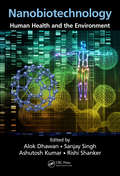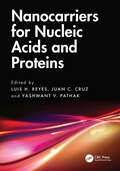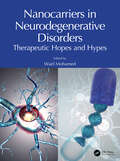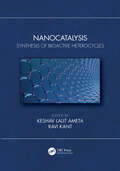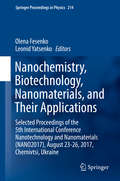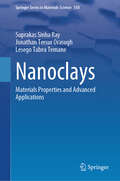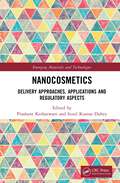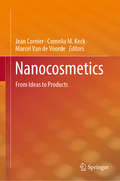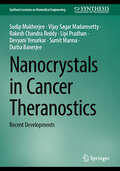- Table View
- List View
NanoBioMaterials
by Bhupinder Singh Rodney J. Y. Ho Jagat R. KanwarThe present book volume presents a holistic view of the aspects of nanobiomaterials incl. their stellar merits and limitations, applications in diverse fields, their futuristic promise in the fields of biomedical science and drug delivery. The federal & regulatory issues on the usage of nanobiomaterials have been assigned due consideration.
NanoBioMedicine
by Shailendra K. Saxena S. M. Paul KhuranaThis book provides a comprehensive overview of the recent trends in various Nanotechnology-based therapeutics and challenges associated with its development. Nanobiotechnology is an interdisciplinary research that has wide applications in the various fields of biomedical research. The book discusses the various facets of the application of Nanotechnology in drug delivery, clinical diagnostics, Nanomedicine and treatment of infectious and chronic diseases. The book also highlights the recent advancements on important devices and applications that are based on Nanotechnology in medicine and brief the regulatory and ethical issues related to nanomedical devices. It also reviews the toxicological profile of various nanomaterials and emphasizes the need for safe nanomaterials for clinical use. Finally, the book discusses the recent developments of potential commercial applications of Nanotechnology.
NanoNutraceuticals
by Bhupinder SinghThis book will be a comprehensive account of the various facets of nutraceuticals domain. The peruser of this book will find details on various nanotech approaches to nutraceuticals, prebiotics and probiotics, along with their specific applications.
Nanoarchitectonics for Brain Drug Delivery (Advances in Bionanotechnology)
by Jay Singh Vivek K. Chaturvedi Anurag Kumar SinghThis book discusses basics of brain diseases and the role of nanobiotechnology in existing treatment options for neurodegenerative disorders. It begins with an overview of brain diseases and the need for novel drug-delivery approaches. It highlights the current route for the intranasal advanced drug-delivery systems for brain diseases. It also discusses innovative categories of drug-delivery systems, including mesoporous silica nanoparticles, polymeric nanocarriers, and lipid-based nanocarriers through multi-responsive DDSs and their implications in brain disorders.Features: Includes an overview of brain diseases and highlights the need for novel drug-delivery approaches Focuses on theoretical aspects of advanced drug-delivery systems for brain diseases including challenges and progress in nose-to-brain delivery Provides an overview of technological approaches and their implications for neurodegenerative disorders, central nervous system (CNS), and brain drug delivery in brain cancer Discusses key advances in the development of polymer nanoparticles for drug delivery to the CNS Reviews the role of herbal medicines and naturally derived polymeric nanoparticle for the treatment of neurodegenerative disorders This book is aimed at graduate students and researchers in biomedical engineering, biotechnology, drug delivery, and neurology.
Nanobioceramics for Bone Tissue Engineering and Regenerative Biomedicine: Tunable Biological Characteristics (Biological and Medical Physics, Biomedical Engineering)
by Reza Gholami Seyed Morteza NaghibThis book presents the tunable biological characteristics of nanobioceramics and focuses on some challenges in bone tissue engineering and regenerative medicine. Synthetic composite-based materials and scaffolds should be biodegradable, biocompatible and supply sufficient structural aid for cell migration, along with oxygen, waste, and nutrient carriage to accelerate bone regeneration process and remodeling in defects. These properties may be reached by functioning tunable physical features, including absorption rate, degradation rate, modulus, porosity, and swelling by adjustments with the addition of ceramic phases and copolymers as synthetic composite scaffolds. Synthetic bioceramics seek to imitate the natural hydroxyapatite (HA) crystal creation located in bone. These ceramics, particularly calcium phosphates, have exhibited great osteoinductivity, osteoconductivity, and biocompatibility. Lately, silicon-based glass-ceramics have been investigated as a substitution of calcium phosphates. Several members of this collection exhibit high bioactivity, have attractive mechanical strength, and are known to increase cell proliferation, adhesion, and mineralization of extracellular matrix. Moreover, antibacterial properties of some nanostructured bioceramics established significant interests in avoiding implants rejection in surgery and biomedicine.
Nanobiomaterial Engineering: Concepts and Their Applications in Biomedicine and Diagnostics
by Pranjal Chandra Rajiv PrakashThis book comprehensively documents the application of Nanobiomaterials in the field of bio-medicine and diagnostics technologies by involving classical concepts/examples. Nanobiotechnology is an emerging area which encompasses all the facets of research of nano and biomaterials with their interaction with biological systems. The book briefly summarizes the various types of Nanomaterial’s, and highlights the recent developments in the synthesis of the nanomaterials for the diagnostic and therapeutic biomedical applications. It skilfully reviews the utilization of the nanomaterials alone or in combination with other bio-molecules as a contrast enhancer in in-vivo imaging, Nano-Theranostics, drug delivery, and sensing transducer matrix. It also discusses the current research on designing of the new Nanobiomaterials and their implementation in numerous fields including bio-medicine and diagnostics. Finally, it summarizes the future prospects and the commercial viability of Nanobiomaterials in the human health care.
Nanobiomaterials Handbook
by Balaji SitharamanNanobiomaterials exhibit distinctive characteristics, including mechanical, electrical, and optical properties, which make them suitable for a variety of biological applications. Because of their versatility, they are poised to play a central role in nanobiotechnology and make significant contributions to biomedical research and healthcare. Nanobio
Nanobiomaterials: Development and Applications (Advances in Materials Science and Engineering)
by Dong Kee Yi Georgia C. PapaefthymiouThere is a continuous exchange of ideas taking place at the border of the biological and physical sciences in many areas of nanoscience. Nanotechnology uses biomimetic or bio-inspired processes to produce nanosized materials for applications in biology and other fields. In return, the fruits of nanotechnology are applied to expanding areas of biome
Nanobiosensors for Agricultural, Medical and Environmental Applications
by Altaf Ahmad Mohd. Mohsin Ruphi NazThis informative book compiles the most up-to-date applications of nanobiosensors in fields ranging from agriculture to medicine. The introductory section describes different types of nanobiosensors and use of nanobiosensors towards a sustainable environment. The applications are divided into four broad sections for easy reading and understanding. The book discusses how manipulation, control and integration of atoms and molecules are used to form materials, structures, devices and systems in nano-scale. Chapters in the book shed light on the use of nanosensors in diagnostics and medical devices. Application in food processing as well as in cell signaling is also described. Nanobiosensors have immense use, and this book captures the most important ones.
Nanobiosensors for point-of-care medical diagnostics
by Manashjit Gogoi Sanjukta Patra Debasree KunduThis book examines the role of nanobiosensors in point-of-care applications for personalized healthcare and management. It begins by discussing various biomaterials that are used for the development of biosensors in medical diagnostics, and reviews advances in their fabrication and the miniaturization of biosensor devices for lab-on-chip analysis. In turn, it explores the rapidly evolving applications of nanomaterials in the context of biomaterial diagnostics. The book also explores the immense potential of biosensors in medical diagnostics, where they are increasingly being used to detect a wide range of biomolecules and biomarkers. In closing, it discusses the current challenges and outlines the future role of nanobiosensors in the development of next-generation point-of-care applications.
Nanobiotechnology for Green Environment
by Amit Kumar Chhotu RamThe book examines environmental issues and their solutions with advancements in biotechnology and nanotechnology. This book will focus on environmental friendly waste management, wastewater treatment, and utilization of wastes for energy. As humanity is struggling for clean air, water and even contaminant free food, our society must ponder the condition of environment. This book covers a variety of environmental issues and how they could be solved through innovations in science, engineering and technology. The authors examine the use of biotechnological methods to remediate wastewater, toxic organic compounds and sludge management problems. The topics include different research disciplines such as water and wastewater treatment, solid waste management and utilization of wastes for energy. This book will be useful for researchers, students, scientists and academicians who are working in multidisciplinary areas like microbiology, biotechnology, nanotechnology to address environmental issues such as water and wastewater treatment, solid waste management and energy resources. Nanobiotechnology for Green Environment covers a variety of environmental issues and how they could be solved through innovations in science, engineering and technology.
Nanobiotechnology for Safe Bioactive Nanobiomaterials (Novel Biotechnological Applications for Waste to Value Conversion)
by Dhanesh Tiwary Poushpi Dwivedi Shahid S. Narvi Ravi Prakash TewariThis book begins with an introduction of nanobiotechnology, followed by biosyntheses of AgNPs, development of silver/chitosan (Ag/CS) polymer nanocomposites, synthesis of silver/chitosan-g-poly acrylamide (Ag/CS-g-PAAm) nanocomposite hydrogel and silver/chitosan/poly vinyl chloride (Ag/CS/PVC) blend. Finally, it presents novel bioengineering of polyfunctional metallic nanostructures other than Ag, emphasizing biomass utilization and value-added conversion over an extended span, including life cycle assessment of the synthesized nanostructures. Features: Includes prospective cost effective, eco-friendly, and safe nanomaterials, synthesized through facile paths Covers the synergistic effect of phytochemicals and nano-Ag antimicrobial agents from an antiviral perspective Includes surface coating systems and super absorbent materials for biomedical purposes Examines nanobiotechnological applications for generating nanoalloys with synchronized nanostructural arrangement of alkaline earth metals and nanoscale dots of transition metals Explores the life cycle assessment of synthesized nanomaterials This book aims at researchers and graduate students in biomaterials, chemical engineering, green chemistry, nanomaterials, and biotechnology.
Nanobiotechnology in Bioformulations (Nanotechnology in the Life Sciences)
by Manoj Kumar Ram Prasad Vivek Kumar Devendra ChoudharyWith the recent shift of chemical fertilizers and pesticides to organic agriculture, the employment of microbes that perform significant beneficial functions for plants has been highlighted. This book presents timely discussion and coverage on the use of microbial formulations, which range from powdered or charcoal-based to solution and secondary metabolite-based bioformulations. Bioformulation development of biofertilizers and biopesticides coupled with the advantages of nanobiotechnology propose significant applications in the agricultural section including nanobiosensors, nanoherbicides, and smart transport systems for the regulated release of agrochemical. Moreover, the formulation of secondary metabolites against individual phytopathogens could be used irrespective of geographical positions with higher disease incidences. The prospective advantages and uses of nanobiotechnology generate tremendous interest, as it could augment production of agricultural produce while being cost-effective both energetically and economically. This bioformulation approach is incomparable to existing technology, as the bioformulation would explicitly target the particular pathogen without harming the natural microbiome of the ecosystem.Nanobiotechnology in Bioformulations covers the constraints associated with large-scale development and commercialization of bioinoculant formations. Furthermore, exclusive emphasis is be placed on next-generation efficient bioinoculants having secondary metabolite formulations with longer shelf life and advanced competence against several phytopathogens. Valuable chapters deal with bioformulation strategies that use divergent groups of the microbiome and include detailed diagrammatic and pictorial representation. This book will be highly beneficial for both experts and novices in the fields of microbial bioformulation, nanotechnology, and nano-microbiotechnology. It discusses the prevailing status and applications available for microbial researchers and scientists, agronomists, students, environmentalists, agriculturists, and agribusiness professionals, as well as to anyone devoted to sustaining the ecosystem.
Nanobiotechnology in Neurodegenerative Diseases
by Mahendra Rai Alka YadavThis book focuses on neurodegenerative diseases which have become a major threat to human health. Neurodegenerative diseases are age related disorders and have become increasingly prevalent in the elderly population in recent years. Hence, there is an urgent need to study and develop new strategies and alternative methods for the treatment of neurodegenerative diseases. This book showcases the promises that nanobiotechnology brings in research, diagnosis, and treatment of neurodegenerative diseases. It is very beneficial for varied group of readers including nanotechnologists, biotechnologists, pharmacists, medical professionals, bioengineers, biochemists and researchers working in this field. Nanobiotechnology in Neurodegenerative Diseases include various chapters including neurodegeneration and neurodegenerative diseases, nanotechnology for the rescue of neurodegenerative diseases, promising potential of nanomaterials for diagnosis and therapy of neurodegenerative diseases, nanotechnology mediated nose-to-brain drug delivery, and formulation and characterization of intranasal nanoparticles of antiretroviral drugs.
Nanobiotechnology: Applications of Nanomaterials in Biotechnology, Medicine and Healthcare
by Kalyan Gayen Tridib Kumar Bhowmick Sunil K. MaityThis book covers topics related to drug delivery, biomaterials, drug design, formulation development, nanoscience, and nanotechnology. It describes the fundamental concepts in nanotechnology and their different applications in biotechnology to solve engineering challenges and generate new areas of technological development. Nanobiotechnology: Applications of Nanomaterials in Biotechnology, Medicine, and Healthcare covers vast application areas that include medical science, material science, pharmaceutical science, and environmental science. Section 1 presents recent research updates on the different nanomaterials, which are promising in different medical and biotechnological applications. Applications of nanomaterials as bone replacement orthopedic implants have revolutionized the treatment of orthopedic surgery. Nanostructured polymeric materials have gained immense research attention as therapeutic carriers for the precise delivery of drugs at targeted sites. Nanocellulose is recognized as a promising green nanomaterial due to its renewability and abundance in nature. Scientific topics on the most recent scientific and technological advances and applications of different nanostructured materials are presented in this section. Section 2 focuses on the novel synthesis methods that are used extensively and are promising for large-scale production of inorganic and nanostructured materials. Section 3 covers the applications of nanotools in the treatment of different diseases, including cancers and genetic diseases. The increasing use of nanotechnology will bring changes in the manufacturing processes of nanomaterials. The applications of nanomaterials in the field of medical imaging and molecular detection are presented in section 4. This book will be useful for students, researchers, scientists, academicians, and industrial manufacturers to understand the importance and applicability of nanomaterials in the field of biotechnology and medical science.
Nanobiotechnology: Human Health and the Environment
by Alok Dhawan, Sanjay Singh, Ashutosh Kumar and Rishi ShankerThis book combines the contributions from the experts of material science, molecular biology, toxicology bio-organic and bio-inorganic chemistry, toxicologists and environmental and food technology etc. to fathom the full scope of current and future of developments in the area of Nanobiotechnology. Provides brief overview of nanobiotechnology for general readers who are not familiar with the research fields and presents a strong overview of most of the critical areas in field This book can also be used as text book for graduate students as an essential reference material, and as an reading material for general readers having a curiosity in Nanobiotechnology.
Nanocarriers for Nucleic Acids and Proteins
by Yashwant V Pathak Luis H Reyes Juan C CruzAt the frontier of modern medicine lies a revolution in drug delivery systems that operates at the scale of billionths of a meter. Nanocarriers for Nucleic Acids and Proteins presents a comprehensive exploration of these groundbreaking technologies that are reshaping therapeutic approaches across medical science.From fundamental concepts to cutting-edge applications, this comprehensive volume brings together world-class researchers to provide an in-depth examination of: Design principles and characteristics of various nanocarrier systems Advanced delivery mechanisms for nucleic acids and proteins Breakthrough applications in gene therapy and cancer immunotherapy Critical aspects of translating laboratory success to clinical implementation Featuring detailed coverage of lipid-based, polymer-based, inorganic, and bio-inspired nanocarriers, this essential resource bridges the gap between theoretical understanding and practical application. Whether you are developing new therapeutic approaches, optimizing delivery systems, or exploring the frontiers of nanomedicine, this comprehensive guide provides the insights and frameworks needed to advance your work.
Nanocarriers in Neurodegenerative Disorders: Therapeutic Hopes and Hypes
by Wael MohamedDue to the lack of secure, efficient, and patient-friendly therapies for neurodegenerative disorders, there is a rising demand for innovative approaches. Despite the limited number of nanocarriers approved for human use, they have demonstrated significant potential in preclinical and, in some instances, clinical trials. In alignment with this objective, the chapters of the book are structured to offer a comprehensive overview of recent advancements in medication and dosage form development, specifically emphasizing the nanoparticulate system for targeting the brain. This book aims to furnish readers with a thorough understanding of the clinical application of nanocarrier systems for treating neurodegenerative disorders, encompassing the latest developments, challenges, safety concerns, toxicity issues, regulatory considerations, prospects, and limitations. Individuals in academia, the scientific community, business, and education seeking a more effective approach to target the brain will find valuable insights in this resource.Key Features Provides a comparative perspective of various nanocarrier systems, therefore facilitating the researcher's selection of appropriate nanoparticulate carriers Highlights the related restrictions of brain delivery and current available medicines Includes information on the advantages and disadvantages of various biomaterials utilized in the development of nanocarriers for brain targeting Emphasizes distinct facets of surface functionalization according to the brain area of interest Presents the current advances, preclinical and clinical development, and the future potential of multiple brain-targeting technologies
Nanocarriers: An Evidence Based Approach
by Nirmal ShahA suitable drug delivery system is an essential element in achieving efficient therapeutic responses of drug molecules. With this desirability in mind, the book unites different techniques through which extremely small-sized particles can be utilized as a successful carrier for curing chronic as well as life-threatening diseased conditions. This is a highly informative and prudently organized book, providing scientific insight for readers with an interest in nanotechnology. Beginning with an overview of nanocarriers, the book impetuses on to explore other essential ways through which these carriers can be employed for drug delivery to varieties of administrative routes. This book discusses the functional and significant features of nanotechnology in terms of Lymphatic and other drug targeting deliveries. The book is presenting depth acquaintance for various vesicular and particulate nano-drug delivery carriers, utilized successfully in Pharmaceutical as well as in Cosmeceutical industries along with brief information on their related toxicities. In addition, the work also explores the potential applications of nanocarriers in biotechnology sciences for the prompt and safe delivery of nucleic acid, protein, and peptide-based drugs. An exclusive section in the book illuminates the prominence and competent applicability of nanotechnology in the treatment of oral cancer. The persistence of this book is to provide basic to advanced information for different novel carriers which are under scale-up consideration for the extensive commercialization. The book also includes recent discoveries and the latest patents of such nanocarriers. The cutting-edge evidence of these nanocarriers available in this book is beneficial to students, research scholars, and fellows for promoting their advanced research.
Nanocatalysis: Synthesis of Bioactive Heterocycles
by Keshav Lalit AmetaThe field of nanocatalysis is undergoing rapid development. Nanocatalysis can help in designing catalysts with excellent activity, greater selectivity, and high stability. Their properties can easily be tuned by tailoring the size, shape, and morphology of the particular nanomaterial. Exhibiting both homogeneous and heterogeneous catalytic properties, nanocatalysts allow for rapid and selective chemical transformations, with the benefits of excellent product yield and ease of catalyst separation and recovery. Nanocatalysis: Synthesis of Bioactive Heterocycles reviews the catalytic performance and the synthesis and characterization of nanocatalysts, examining the current state of the art and pointing the way towards new avenues of research specially synthesis of bioactive heterocycles. Top researchers summarize synthetic methodologies for the synthesis of bioactive heterocycles using a nanocatalytic framework. The catalytic performance and the synthesis and characterization of nanocatalysts are reviewed. State of the art methods and new and emerging applications of nanocatalysts in the synthesis of biologically active heterocycles are detailed. Additional features include: Focuses on designing and synthesizing nanocatalysts specifically for the synthesis of different bioactive heterocycles. Demonstrates how nanocatalysis can produce catalysts with excellent activity, greater selectivity, and high stability. Explores tuning catalysts properties by tailoring the size, shape, and morphology of a nanomaterial. Offers the reader insights into the field of nanoscience via nanocatalysis. Nanocatalysis: Synthesis of Bioactive Heterocycles is a must read for researchers in organic chemistry, medicinal chemistry and biochemistry.
Nanochemistry, Biotechnology, Nanomaterials, and Their Applications: Selected Proceedings of the 5th International Conference Nanotechnology and Nanomaterials (NANO2017), August 23-26, 2017, Chernivtsi, Ukraine (Springer Proceedings in Physics #214)
by Leonid Yatsenko Olena FesenkoThis book presents some of the latest achievements in nanotechnology and nanomaterials from leading researchers in Ukraine, Europe, and beyond. It features selected peer-reviewed contributions from participants in the 5th International Science and Practice Conference Nanotechnology and Nanomaterials (NANO2017) held in Chernivtsi, Ukraine on August 23-26, 2017. The International Conference was organized jointly by the Institute of Physics of the National Academy of Sciences of Ukraine, Ivan Franko National University of Lviv (Ukraine), University of Tartu (Estonia), University of Turin (Italy), and Pierre and Marie Curie University (France). Internationally recognized experts from a wide range of universities and research institutions share their knowledge and key results on topics ranging from energy storage to biomedical applications. This book's companion volume also addresses nanooptics, nanoplasmonics, and interface studies.
Nanoclays: Materials Properties and Advanced Applications (Springer Series in Materials Science #350)
by Suprakas Sinha Ray Lesego Tabea Temane Jonathan Tersur OrasughThis book covers natural and synthetic nanoclays, focusing on the fundamentals of nanoclay-chemistry and applications in advanced technologies. For millennia, clay has been an indispensable part of human civilization, playing an especially fundamental role in modern society in the form of e.g. porcelain, ceramics, bricks, and tiles, as well as being an essential constituent for plastics, paints, paper, rubber, cosmetics, sensors, and medicinal products.The book introduces the reader to nanoclays, most commonly referred to as layered silicates, which take the form of layered or sheet-like structures with nanometer-scale dimensions. It describes the structure and materials properties of both natural and synthetic nanoclays, and covers their applications in diverse areas such as paint formulations, water purification, cosmetics, biomedical applications, and energy storage. Authored by experts with long-standing experience in industry and academic research, this book serves as a useful reference not only for students and academics interested in this exciting new field, but also industrial researchers and R&D managers wishing to bring nanoclay-based advanced products to market.
Nanocosmetics Delivery Approaches, Applications and Regulatory Aspects: Delivery Approaches, Applications And Regulatory Aspects (Emerging Materials and Technologies)
by Prashant Kesharwani Sunil Kumar DubeyThis book offers an overview of the science of cosmetics and the formulation of nanosized cosmetic products including fabrication, characterization of nanocosmetics, major challenges in the safe applications, regulatory aspects, and commercialization on a large scale. The chapters provide understanding of the interaction of nanocarriers with skin and hair, different nanocosmetic products in the present situation, applications as well as disadvantageous toxicity associated with nanocosmetics, regulatory prospects, and future perspectives. Features: Provide an explicit account on vital aspects of various nanocosmetics drug delivery approaches, thereby providing a next-generation cosmetic product. Bring together the novel applications of nanocosmetics approaches in the biological milieu. Explores preparation, applications, toxicity, and regulatory prospects. Includes a dedicated chapter on Niosomal drug-delivery systems in cosmetics. Discusses the perspectives of the technologies explored so far based upon the findings outlined in highly organized tables, illustrative figures, and flow charts. This book is aimed at researchers and professionals in nanomedicine, pharmaceuticals, biotechnology, and the health sector.
Nanocosmetics: From Ideas to Products
by Marcel Van de Voorde Jean Cornier Cornelia M. KeckThis book addresses the application of nanotechnology to cosmetics. Edited by three respected experts in the field, the book begins with a general overview of the science behind cosmetics and skin care today, and of the status quo of nanotechnology in cosmetics. Subsequent chapters provide detailed information on the different nanoparticles currently used in cosmetics; the production and characterization of nanoparticles and nanocosmetics; and regulatory, safety and commercialization aspects. Given its scope, the book offers an indispensable guide for scientists in academia and industry, technicians and students, as well as a useful resource for decision-makers in the field and consumer organizations.Chapter 6 of this book is available open access under a CC BY 4.0 licence at link.springer.com.
Nanocrystals in Cancer Theranostics: Recent Developments (Synthesis Lectures on Biomedical Engineering)
by Sudip Mukherjee Vijay Sagar Madamsetty Rakesh Chandra Reddy Lipi Pradhan Devyani Yenurkar Sumit Manna Durba BanerjeeNanocrystals have been established as an important cancer diagnosis and therapeutic tool due to their ability to deliver poorly soluble drugs with sustained release, low toxicity, and flexibility of administration. In this book, the importance and current status of nanocrystals in cancer therapy are presented, along with challenges, and future prospects. The book focuses on several therapies of nanocrystals, including anticancer, immunotherapy, radiotherapy, biotheranostics, targeted therapy, photothermal, and photodynamic. Further, different imaging and diagnostics using nanocrystals are mentioned, including magnetic resonance imaging (MRI), computed tomography (CT), biosensing, and luminescence. Finally, the limitations and potential solutions of nanocrystals in the field of cancer theranostics are also discussed.
